IDEX Online Research: Jewelry Price Inflation Virtually Nil At All Levels in July
August 24, 09
Jewelry price inflation at both the retail level and the supplier level were almost nil in July. At the producer level, prices were down 0.1 percent while they rose by a miniscule 0.3 percent at the retail level.
What A Difference A Year Makes
How does this year’s lack of inflation compare to just one year ago? The following graph compares and contrasts the Jewelry Consumer Price Index (JCPI) and the Jewelry Producer Price Index (JPPI) for July 2009 with July 2008. Last year, the flames of inflation in the jewelry industry were at record levels, running at about five-to-six times the level of the long term run rate of 1.5 percent for inflation at both the retail and supplier level. It is clear that inflation appears to have disappeared.
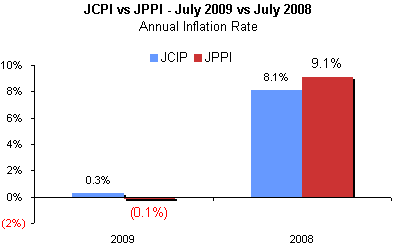
Source: BLS
Free-Market Economy Brings Prices and Inflation Back in Balance in Pipeline
In addition to almost no price inflation in the pipeline in July, another highly unusual trend ended in July. Last month, we asked the question in our headline: “Retail jewelry prices down, supplier prices up. How much longer?” We now have our answer: July. In a supply-and-demand driven free-market economy, prices can’t diverge at different levels for any length of time. Capitalism – and the forces of supply and demand in a free market – will bring prices and inflation back into balance eventually. That’s what happened in July.
Retail jewelry and watch price inflation (Jewelry Consumer Price Inflation – JCPI) has been dropping virtually every month from its peak in August 2008, when inflation reached 9.0 percent on an annualized basis. At the beginning of 2009, jewelry and watch price inflation at the retail level had moderated to 4.9 percent annually; it has dropped each month this year, reaching +0.3 percent in July.
Producer price inflation for jewelry (Jewelry Producer Price Inflation – JPPI) also showed a similar decline in 2008, but 2009 trends were exactly opposite of retail consumer price inflation. Each month, the JPPI would rise, but the JCPI would fall.
Any economist looking at these trends would scratch his or her head, and say, “This can’t last.” And, now, it is clear: it couldn’t last, and it didn’t last.
The graph below summarizes the contradiction that JCPI and JPPI showed for the first six months of 2009, followed by a major correction in the JPPI in July. The Jewelry CPI is represented by the green bars, while the Jewelry PPI is represented by the red bars.
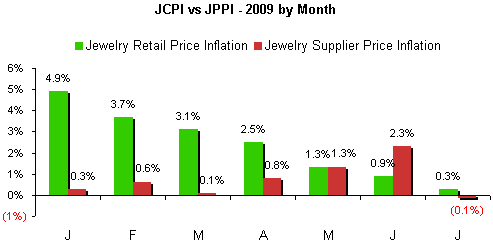
Source: BLS
Jewelry Price Inflation: July 2009
Here’s the summary of inflation at the jewelry retail and supplier level for the month of July 2009, as expressed as a percentage change year-over-year (July 2009 versus July 2008) in the U.S. market:
- Jewelry Producer Price Index (0.1 percent)
- Platinum & Gold Used in Jewelry +0.3 percent
- Other Precious Metals Used in Jewelry 2.6 percent*
- Watches & clocks +1.9 percent*
- Findings, Materials & Lapidary Work +9.4 percent (since December 2008)*
- Jewelry & Watch Consumer Price Index +0.3 percent
- Jewelry CPI +0.6 percent
- Watch CPI (1.4 percent)
* New JPPI measures
The Bureau of Labor Statistics (BLS) recently developed several new sub-categories for the Jewelry Producer Price Index, including “Other Precious Metals Used in Jewelry” and “Jewelers' Findings & Materials, Including Lapidary Work.” In the past, these items were included in other categories. The new precious metals category includes “Jewelry made of silver; jewelry made of other metals, but clad or plated in gold, silver or platinum; jewelry made of precious or semi-precious stones; and other miscellaneous jewelry products made from precious metals such as cuff links and money clips.” April’s inflation rate for this new category was +4.0 percent; May’s rate was a deflation rate of 0.3 percent; June’s rate of inflation was 1.6 percent; and, as noted on the table above, July’s rate of inflation was 2.6 percent. These large swings suggest that there may be a sampling aberration that needs correcting.
Further, we have added a category to the JPPI – “watches and clocks.” While the BLS has published this category for a while, it is not clear how much weight “watches” have versus “clocks.” The BLS has also developed new categories for silver jewelry at the producer level as well as jewelry retail trade services at the store level (essentially jewelers’ labor costs). However, these measures have only a couple of months of history; hence, we will not report them, unless there are severe swings, until we are satisfied that they are recording reality properly.
 |
The July JPPI was well below the average of the Jewelry Producer Price Index for 2008, which averaged +6.3 percent for the full year, and the +0.1 percent in July is also well below the annual inflation rate – which averaged about +0.7 percent – that characterized the jewelry producer industry in 2000 through 2002, also a recessionary period. July’s inflation rate was also well below the long term Jewelry Producer Price Index increase of about +1.4-1.5 percent annually.
The following graph summarizes the monthly Jewelry Producer Price Index for inflation since mid-2007. The percentage figures are based on year-to-year comparisons of the BLS Jewelry Producer Price Index (July 2009 versus July 2008).
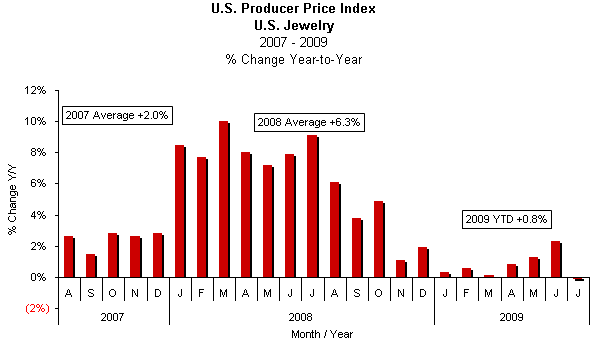
Source: BLS
After showing only very modest increases earlier this year, prices for both precious metal jewelry and gemstone jewelry rose in the second quarter, only to fall back in July. The graph below compares the JPPI (red bars) to inflation for precious metals (gold bars); gold had been the primary driver of precious metals inflation in 2007 and most of 2008. In January 2009, gold prices pulled back modestly, but rose recently. In our opinion, $1,000 gold has been priced into goods produced by jewelry manufacturers. If gold goes higher, as some analysts suggest, that will put further pressure on jewelry suppliers to raise prices.
As the graph below illustrates, prices for precious metals used in jewelry at the supplier (producer) level showed notable inflation, but retreated in July.
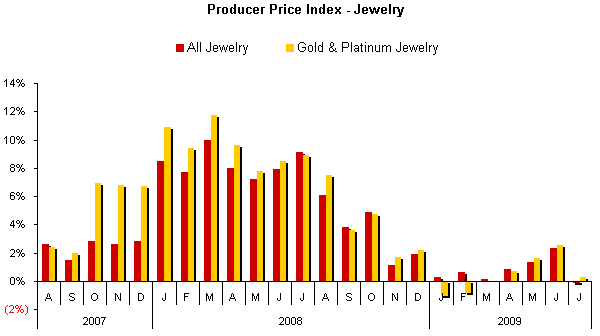
Source: BLS
Watch price inflation at the producer level has bounced all around over the past year. Like all producer prices, watch prices heated up in 2008, only to begin a relentless decline in the second half of the year. By January 2009, watch prices were reflecting deflation. However, watch prices began to climb in the second quarter. In July, watch price inflation collapsed, roughly in line with all jewelry supplier prices.
The following graph summarizes producer price inflation and deflation for watches in the U.S. market.
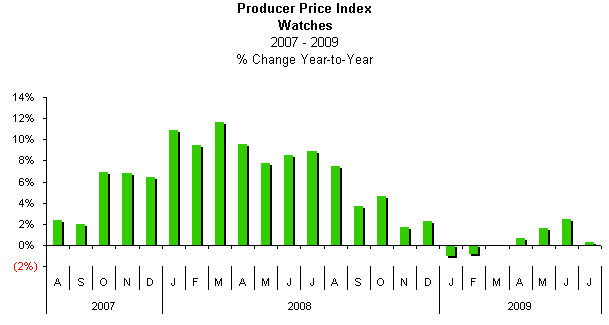
Source: BLS
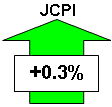 |
For the full year 2008, retail price inflation for jewelry in the U.S. market ran at an annual rate of +6.9 percent. Now, however, it is clear that jewelry price inflation is moderating, and it will likely remain lower than 2008 in the coming months, especially as we reach the anniversary of last year’s price increases that jewelers implemented in the second quarter of 2008. We had originally predicted that retail jewelry price inflation might be flat in 2009; this is unlikely, but the year-to-date average continues to fall each month. For the seven months year-to-date, retail price inflation for jewelry is +2.4 percent.
The graph below summarizes the percentage change in retail prices of jewelry and watches by month on a year-to-year basis since the beginning of 2008. The percentage change is based on a comparison to the same month a year ago (July 2009 versus July 2008).
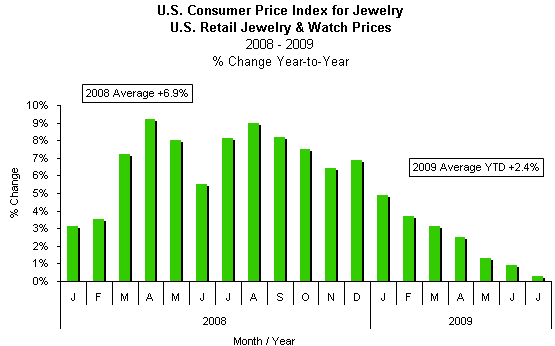
Source: BLS
Watch Prices Show Deflation in July
After bouncing around for several months, it became clear in the second quarter of 2009 that watch price inflation at the retail level was moderating. Early in 2008, the components of jewelry and watch price inflation at the retail level reflected a disparity in price increases. Jewelry retail prices were up consistently during the first half of 2008, but watch retail prices showed virtually no price inflation. Earlier this year, watch price inflation steadily increased. In April, watch price inflation slowed dramatically. In May, retail prices of watches inched higher than in April, but the inflation rate was still below earlier months in 2009. In June, watch price inflation diminished significantly. In July, watch prices dipped – experienced deflation – in the U.S. market. We expect watch price inflation to track more closely to retail jewelry price inflation over the near term.
The graph below illustrates the JCPI consisting of both jewelry and watch prices (green bars), jewelry prices only (red bars), and watch prices (yellow bars).
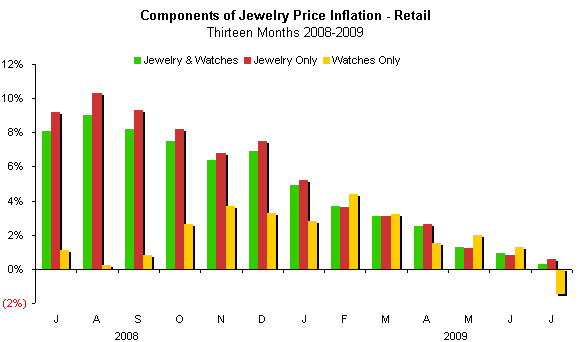
Source: BLS
Outlook: Modest Jewelry Price Inflation in 2009
After rising by nearly 7 percent in 2008, we continue to forecast much more modest jewelry and watch price inflation during 2009. The wild card, of course, is the price of commodities, including gold, silver, and platinum. If investors continue to buy these commodities as hedges against inflation – as historical economic recovery models suggest – it will put upward cost pressure on jewelry suppliers, who will try to pass those price increases along to retailers.
Our current prediction calls for 2009 jewelry price inflation to be in the low single digit positive level. The U.S. economy – which accounts for roughly half of all jewelry demand worldwide (by value) – is showing signs that the recession has bottomed (recently, one economist even went so far as to declare that the recession had ended in June!). Thus, if consumer demand recovers, we won’t experience price deflation; instead, we could experience modest price inflation.